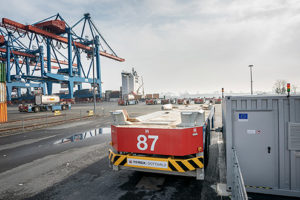
Hamburger Hafen und Logistik AG (HHLA), the leading European port and transport logistics group, has announced that it will use automated guided vehicles (AGVs) powered by lithium-ion batteries to move containers at its Container Terminal Alternwerder (CTA) between ships and the yard in future.
The terminal has been testing a prototype of this container transporter together with an electric charging station since autumn 2016. Following the successful probation, six of these charging stations have already been installed at Altenwerder. Over the coming weeks, 25 lithium-ion battery-powered AGVs will go into operation at the CTA. By the end of 2022, the fleet of almost 100 AGVs will be completely switched over to lithium-ion battery drive and a total of 18 charging stations will be installed. This will result in an annual reduction in emissions of approximately 15,500 tonnes of CO2 and around 118 tonnes of nitrogen oxide.
Besides, according to the terminal operator, the vehicles are also more efficient than their diesel-powered predecessors, as their ratio of energy consumed to actual power output is three times higher. Further advantages of the lithium-ion batteries include their high durability, short charging time (only 1.5 hours) and lower weight as compared to lead batteries (4 tonnes against 12 tonnes). Lithium-ion batteries also do not require any upkeep, unlike lead acid batteries, which reduces costs and down times resulting from maintenance work.
Another benefit is that during their time at the charging station, AGVs can contribute to the stabilisation of the grid by precisely extracting or feeding energy. For example, if there is no wind over the North Sea at that time, software will signal that the batteries should feed energy back into the grid in order to immediately balance out the resulting gap between the generation and consumption of energy. And on the contrary, if the offshore wind turbines are turning particularly fast, while lots of solar energy is being generated, the batteries will receive a signal to begin charging. This makes the container transporters flexible power storage units with an output of approximately 2 megawatts on the energy market, using intelligent interconnectivity.
This innovative energy transition project of HHLA is supported by the Ministry of Environment and Energy using funds from the European Regional Development Fund (ERDF). The ERDF will provide Hamburg with approximately EUR 55 mln between 2014 and 2020 to increase investment in growth and employment. On 16 April 2018, Jens Kerstan, Hamburg’s Minister of Environment, presented HHLA’s Chairwoman of the Executive Board, Angela Titzrath with the funding of about EUR 8 mln allocated for this project.
“With the high level of automation at CTA, the terminal is already leading the way for container handling of the future,” says Angela Titzrath. “HHLA is making yet another contribution to the Ministry’s air purification plan by using container transporters powered by lithium-ion batteries. The self-imposed target to reduce CO₂ emissions per container by 30% compared to 2008 has been achieved ahead of time. We will now set ourselves new targets, combining entrepreneurial vision, social responsibility and the sustainable use of resources.”
